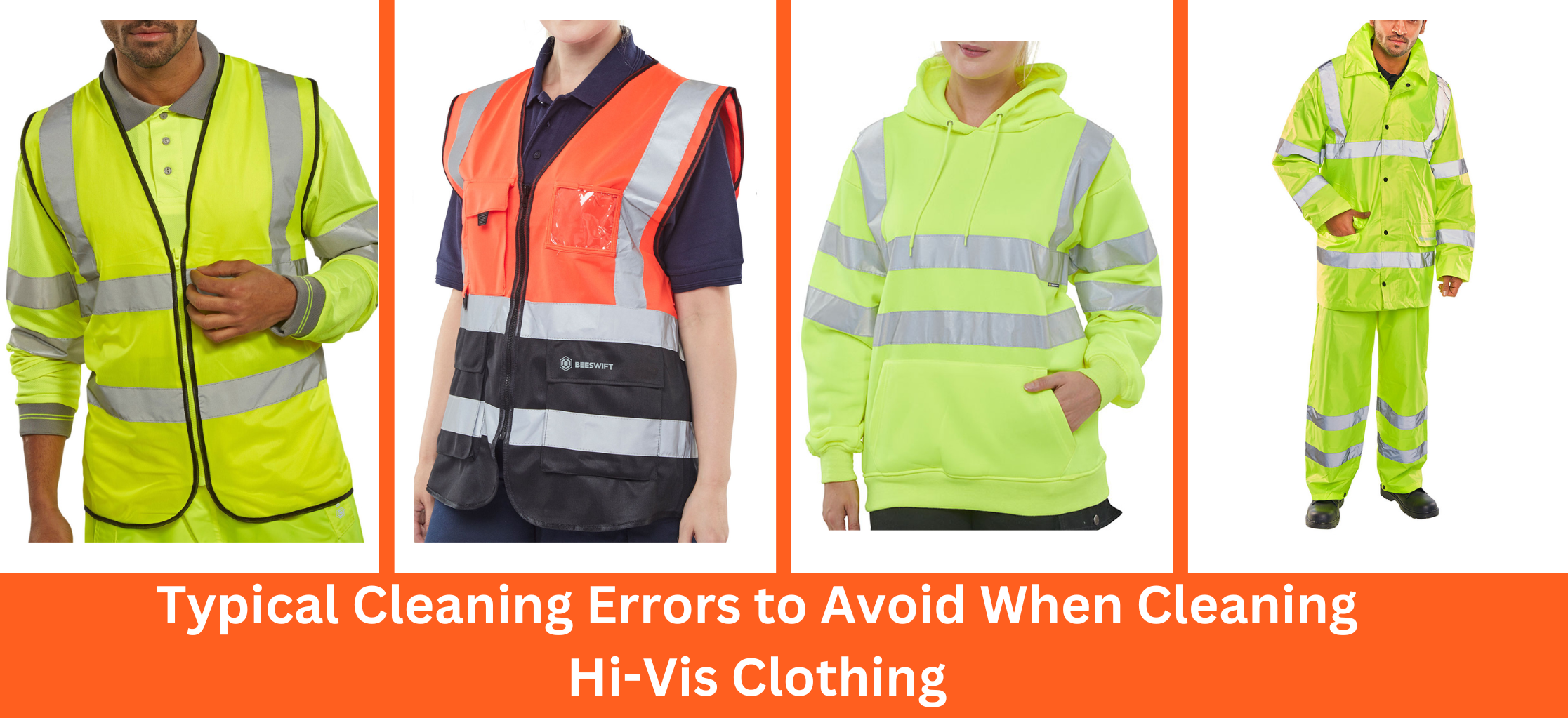Typical Cleaning Errors to Avoid When Cleaning Hi-Vis Clothing
31st Mar 2024
Retroreflective materials and bright textiles are components of high-visibility workwear. Your visibility is enhanced by the clothing' vibrant colours in direct sunshine and by the retroreflective tape in low light.
Wash hi-vis clothing carefully to maintain ANSI compliance and for your personal safety. Continue reading to find out typical cleaning errors with hi-vis clothes to avoid.

Ignoring the Garment's Care Instructions
The tag on your hi-vis clothing will have specific washing recommendations that are meant to preserve the item. Details like machine drying compatibility, wash temperature, and detergent recommendations are included.
If the number of cycles you can wash the clothing on will be limited, it will be specified in the instructions. Throw away the clothing after you've reached that threshold. The objective of hi-vis clothing may be defeated by repeated washings, which can cause the clothing to fade.
Not Getting Ready for the Laundry
It will take a few minutes to prepare your hi-vis clothes for washing by first cleaning any dirt and then applying a pre-treatment to any stains. The washer might become abrasive from too much dirt. Using a clean, dry cloth, remove any remaining debris and shake off any loose dirt.
Use a clean, dry cloth and a light stain remover to gently dab at tough spots. Use stain removers without bleach exclusively.
To remove a stain from fabric, never scrub it. Scrubbing may cause the stain to spread and the fabric to be worn out, which may make the item appear less visible.
Not using a mild detergent for washing
Never use a strong detergent to wash your hi-vis clothing, regardless of how filthy it gets. If you use too much detergent, it could leave a residue that invites dirt. Instead, always use a light, neutral detergent.
Grease and grime are dissolved by surfactants, an essential cleaning component found in mild detergents. Regular detergent washing can deteriorate fabric and harm reflective tape, just like other poor laundry habits.
Applying Fabric Softener or Bleach
Bleach works wonders for a typical load of white clothes. But, it's a strong chemical that can deteriorate fabric fibres and cause your hi-vis clothing to fade. Before beginning the wash cycle, let the fabric soak in water and detergent in your washing machine for 20 minutes if you need a deeper clean than usual.
To lessen static and give your clothes a softer feel, you might want to use fabric softener on your regular loads. Fabric softeners coat fabrics with a waxy layer that might harm your hi-vis clothing, so you should never use them on hi-vis items.
Ignoring to separate rough fabrics from hi-vis apparel
Although sorting clothes may seem tedious, a typical cleaning error you should avoid is combining rough textiles with hi-vis garments. In the washer and dryer, rough materials like denim and hook-and-loop fasteners will constantly scrape against your hi-vis clothing.
Rubbing will wear out the clothing and decrease visibility since it will scrape the fluorescent fabric and retroreflective material. In low-light conditions, scratches on the retroreflective fabric might decrease the coverage of your safety gear and leave you less protected.
Using Hot Water to Wash
Use the delicate cycle on your washer and machine wash hi-vis clothing in cold water. Hot water washing can harm the retroreflective material, twist the fibres, and cause colour bleeding.
A polyester blend is used to make a lot of hi-vis clothing. The fibres may thin or twist as a result of the heat from a hot wash cycle, degrading the garments' look.
Hot water can also damage the spandex fabric in your hi-vis clothing. The spandex fibres will shrink in the hot water, causing the garment to deform.
Line-Drying in the Bright Sun
Certain textiles cannot be dried by machine. Plus, line-drying is kinder on fabrics than machine-drying, even if you can. Avoid exposing hi-vis clothing to direct sunlight when line-drying it.
The vibrant colours of the clothing may fade with prolonged exposure to sunshine. Sunlight's UV rays have the ability to break down chemical bonds in fluorescent pigments, which dulls the colours. Dry clothes should be brought inside as soon as possible after being line dried in the shade.
Not Running the Dryer on Low Heat
Use low heat whenever possible when machine drying hi-vis clothing, if the washing instructions allow it. Elevated temperature settings have the potential to harm the elements securing retroreflective tape. Elevated temperatures may also degrade the textile and retroreflective substance, leading to the fading of bright hues.
Instead of using heat drying, the low heat setting lets the clothing air dry by tossing them around. Don't overfill the dryer since it will take a little longer to dry your items on this setting. Less stuff in the dryer means more air can get around the fabric and dry it more effectively.
To Dry Clothes More Quickly, Wring The
You may be tempted to expedite the drying process, whether you're using a line dryer or your machine set to low heat. To dry your clothing more quickly, you should never wring them out.
Wringing puts undue strain on the clothing by generating a lot of tension in the material. The retroreflective tape may potentially be harmed by this motion.
The way retroreflective tape functions is by minimally dispersing light as it reflects it back to the source. Abrasion will destroy the tiny glass beads or microprisms that make up the retroreflective material, which is used to create the highly focused reflected light.
Leaving Spotless Garments Crumple
The fabric may get harmed if clean clothing are stacked or dried in the dryer. You normally don't have to worry about this for regular loads of washing. However, in order to avoid scratches, you should shield the retroreflective material from needless contact with other objects.
Additionally, hi-vis clothing cannot be ironed. Take your clothing immediately from the dryer to the closet to prevent wrinkles because the concentrated, powerful heat might harm the clothing.
These ten common laundry errors can result in abrasive damage, diminished colour brightness, and weakened fabric. You'll be safe and your hi-vis clothing will look its best if you steer clear of these problems.
Get stylish, highly visible safety clothing from Work Wear Club. Our designs blend form and function to produce fashionable clothing that complies with safety regulations. Get your brand-new hoodie, jacket, or hi-vis shirt right now.Typical Cleaning Errors to Avoid When Cleaning Hi-Vis Clothing

 United Arab Emirates Dirham
United Arab Emirates Dirham
 Australian Dollar
Australian Dollar
 Canadian Dollar
Canadian Dollar
 Euro
Euro
 US Dollar
US Dollar
 FREE UK DELIVERY ON ALL ORDERS OVER £75
FREE UK DELIVERY ON ALL ORDERS OVER £75







